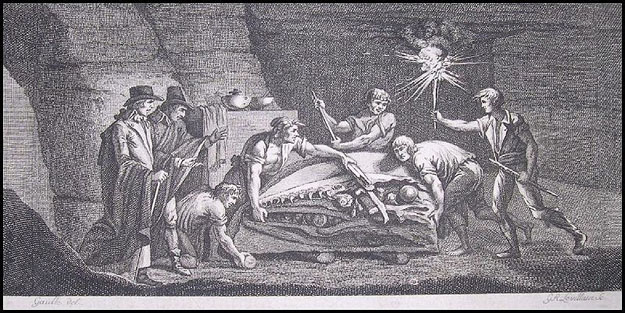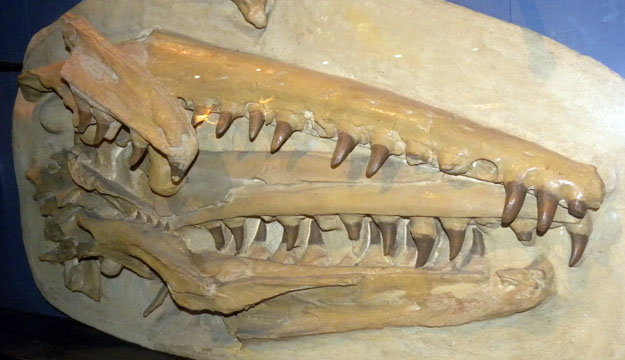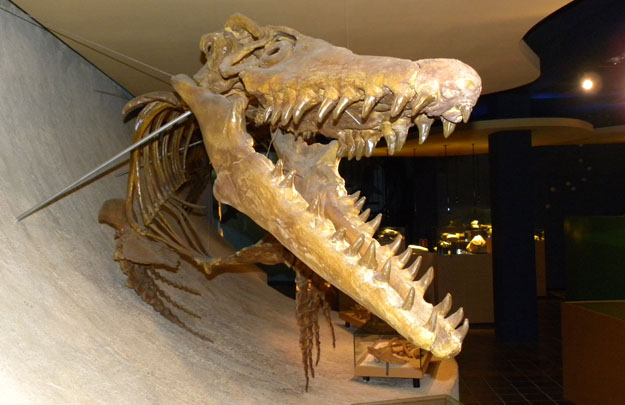
The discovery of a mosasaur in the Maastricht tunnels (1770). Engraving by G. R. Levillaire; image from Wikipedia.
MAASTRICHT, THE NETHERLANDS–Next month I am giving a talk on campus about evolution in a lecture series on “science and religion”. I was particularly intrigued, then, to hear a story about the famous mosasaur discovered in the Maastricht tunnels that highlighted tension between geology and the religious establishment long before Charles Darwin started rocking boats. It was a delight to be in the very tunnels where the drama began.
In 1770 a group of quarrymen in Maastricht discovered the skull of a very large and toothy animal. It was brought to the attention of Johann Leonard Hoffman, a local surgeon and fossil collector, who immediately knew it was very curious and would be of great interest to the savants of Europe. He corresponded with many, producing what we would call a buzz today about this creature. It clearly represented an animal which went extinct — a new concept at the time. How do you explain the existence of a large fossil like this deep underground in The Netherlands? Was it an animal which missed Noah’s Ark? Did God create some animals doomed to extinction?
In 1794 an army from revolutionary France occupied Maastricht. Some officers wanted to seize the fossil and put it on display in Paris because of these questions about God and Creation. They wanted to use this mosasaur (the name came much later) to show that either there was no God or that God was a distant deity unconcerned with Creation. Apparently through bribery and rewards, they found the fossil and indeed shipped it off to Paris. To this day it is in the Paris Museum of Natural History and only a cast of it is in the Maastricht Natural History Museum. (The Dutch have various ways to remind visitors that the French stole the original specimen. European unity only goes so far!)
In Paris the famous geologist Georges Cuvier took an interest in “le Grand Animal de Maastricht” and correctly identified it as a reptile — specifically a kind of marine lizard (a conclusion still supported today). Cuvier used it as evidence for his catastrophic ideas of disasters followed by re-creations of life on Earth.
The Maastricht mosasaur, now known as Mosasaurus hoffmanni, thus was one of the first fossils to be used in the science-religion debates, and this was well before the modern theory of evolution emerged.






Pingback: » The Amniotic Egg: Amphibians to Reptiles (October 20 & 22) History of Life course at The College of Wooster
Pingback: The Amniotic Egg: Amphibians to Reptiles (March 7-11) | History of Life course at The College of Wooster
Pingback: The Amniotic Egg: Amphibians to Reptiles (March 5-9) | History of Life course at The College of Wooster
Pingback: The Amniotic Egg: Amphibians to Reptiles (October 17-19) | History of Life course at The College of Wooster
Pingback: The Amniotic Egg: Amphibians to Reptiles (March 4-8) | History of Life course at The College of Wooster
Pingback: The Amniotic Egg: Amphibians to Reptiles (October 14-18) | History of Life course at The College of Wooster
Pingback: The Amniotic Egg: Amphibians to Reptiles (October 13-17) | History of Life course at The College of Wooster
Pingback: The Amniotic Egg: Amphibians to Reptiles (February 23-27) | History of Life course at The College of Wooster
Pingback: The Amniotic Egg: Amphibians to Reptiles (February 29 – March 4) | History of Life course at The College of Wooster